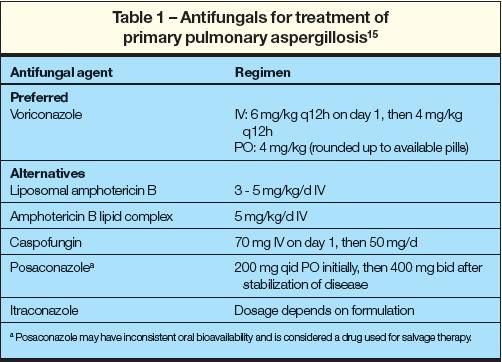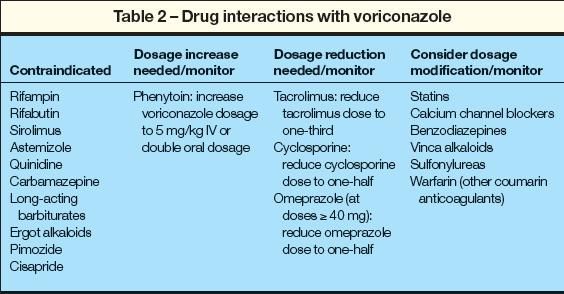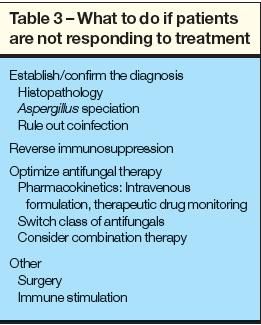- Clinical Technology
- Adult Immunization
- Hepatology
- Pediatric Immunization
- Screening
- Psychiatry
- Allergy
- Women's Health
- Cardiology
- Pediatrics
- Dermatology
- Endocrinology
- Pain Management
- Gastroenterology
- Infectious Disease
- Obesity Medicine
- Rheumatology
- Nephrology
- Neurology
- Pulmonology
Invasive pulmonary aspergillosis, part 2: Treatment
ABSTRACT: In general, the management of invasive pulmonaryaspergillosis is based on antifungal therapy and reversal of immunosuppression.Voriconazole is the preferred treatment inmost cases. Liposomal preparations of amphotericin B, caspofungin,and posaconazole are alternatives in patients whocannot tolerate voriconazole or have refractory aspergillosis.Prophylaxis in high-risk patients has gained popularity withthe availability of oral extended-spectrum azoles; posaconazoleis approved for prophylaxis in patients with acute leukemia,myelodysplastic syndrome, and graft versus host disease.(J Respir Dis. 2008;29(11):429-434)
ABSTRACT:In general, the management of invasive pulmonary aspergillosis is based on antifungal therapy and reversal of immunosuppression. Voriconazole is the preferred treatment in most cases. Liposomal preparations of amphotericin B, caspofungin, and posaconazole are alternatives in patients who cannot tolerate voriconazole or have refractory aspergillosis. Prophylaxis in high-risk patients has gained popularity with the availability of oral extended-spectrum azoles; posaconazole is approved for prophylaxis in patients with acute leukemia, myelodysplastic syndrome, and graft versus host disease. (J Respir Dis. 2008;29(11):429-434)
In the October 2008 issue of The Journal of Respiratory Diseases, we reviewed the clinical presentation and diagnosis of invasive pulmonary aspergillosis. In this article, we will review the treatment options.
Antifungal therapy
Antifungal therapy should be started promptly when aspergillosis is strongly suspected (Table 1). Early treatment may improve survival.1

Voriconazole is recommended for the primary treatment of invasive aspergillosis in most patients.2 It blocks the synthesis of ergosterol, which leads to the destruction of the fungal cell membrane, and is considered fungicidal. Voriconazole is available in both oral and intravenous formulations and is well absorbed and widely distributed in body tissues, including the cerebrospinal fluid. For seriously ill patients, voriconazole should be administered intravenously for the first 7 days, followed by oral therapy twice daily. Oral therapy can be used in stable patients.
Voriconazole is also active against many other fungi, including Candida species; Cryptococcus neoformans; Trichosporon species; filamentous fungi; and dimorphic fungi, such as Coccidioides immitis, Histoplasma capsulatum, and Blastomyces dermatitidis. However, it is not active against Zygomycetes.
Potential adverse effects of voriconazole are visual disturbances, including blurred vision, changes in acuity and color, and photophobia, all of which can occur in up to 20% of patients but are transient and do not lead to permanent problems. Liver function abnormalities occur in about 12% of cases. Our routine is to order liver function tests approximately once per month. Other, less common effects are fever, chills, headache, tachycardia, nausea, vomiting, hallucinations, and rash. The potential for drug interactions should always be considered before starting voriconazole, and appropriate adjustments should be made (Table 2).

Special circumstances in which voriconazole has a unique advantage are CNS infections and Aspergillus terreus infections.3,4 Voriconazole may not be a good choice in patients who are receiving concomitant drugs that have significant interactions and in patients who have abnormal liver function. Nor is it a good choice for breakthrough infections in patients who are receiving prophylaxis with an azole that is active against molds, such as voriconazole, because of the higher incidence of infections caused by mucormycoses and azole-resistant Aspergillus species in this setting.5,6
Deoxycholate amphotericin B (dAMB) is an alternative for patients in whom voriconazole is contraindicated.7 This broad-spectrum polyene antifungal binds to ergosterol in the cell membrane and is fungicidal. Lipid formulations of amphotericin B (LFABs), including liposomal amphotericin B, amphotericin B lipid complex, and amphotericin B colloidal dispersion, are as effective as dAMB, albeit more costly. LFABs have broad coverage of many fungi, with the exception of A terreus.
The polyene antifungals are given as an intravenous formulation. Major adverse effects are infusionrelated fever, chills, and dyspnea as well as nephrotoxicity.8 These are substantially less common and less severe with LFABs than with dAMB.7 Other adverse effects, such as electrolyte imbalance, are common; however, several less common effects, such as hepatotoxicity, cardiac arrhythmias, and cardiac failure, may be important.
A randomized trial compared 2 initial dosages of liposomal amphotericin B (3 and 10 mg/kg/d) and showed similar efficacy but greater toxicity in the higher-dose arm.9 In rare circumstances, an inhaled amphotericin preparation may be used as an adjunct to systemic therapy in patients who have endobronchial Aspergillus infection and may also be used for prophylaxis.10,11
In addition to primary drug therapy, reversal of immunosuppression is crucial for successful treatment of invasive pulmonary aspergillosis. Persistent neutropenia andchronic graft versus host disease (GVHD) are 2 of the most important variables associated with poor outcome.12 Withdrawal of corticosteroids or reduction of dosage is strongly advised when possible. However, several of the newer corticosteroid-sparing immunosuppressive strategies, such as tumor necrosis factor-α, sirolimus, and possibly other immunosuppressive agents, can have deleterious immunological consequences, leading to invasive aspergillosis.12-14
What is the duration of treatment?
The duration of antifungal therapy for invasive pulmonary aspergillosis should be tailored to individual patients. The current guidelines recommend treatment for a minimum of 6 to 12 weeks in immunosuppressed patients or until reversal of immunosuppression and resolution of lesions.15 For patients with successfully treated invasive aspergillosis who will require subsequent immunosuppression, resumption of antifungal therapy can prevent recurrent infection.15
What to do when patients are not responding?
Careful monitoring is required during therapy. The volume of pulmonary infiltrates may increase for the first 7 to 10 days of therapy, especially in the context of granulocyte recovery.16 For patients not responding, several factors should be considered (Table 3):

• Confirm the diagnosis: Detailed evaluation should be performed to confirm the diagnosis. If the diagnosis of aspergillosis was based solely on radiographic findings, other pathogens should be excluded. If the diagnosis was established before, superinfection or emergence of resistance should be considered.
• Salvage therapy: Several antifungal drugs, including caspofungin, LFABs, posaconazole, and itraconazole, have been evaluated in clinical trials as salvage therapy. Response rates have been similar, at about 40% to 50%.17-19 For patients who have aspergillosis that is refractory to voriconazole, a switch of antifungal class is preferable because of possible cross-resistance to other azoles.5,6
Caspofungin, which is approved as salvage therapy for aspergillosis, is an echinocandin that inhibits the synthesis of (1,3)-β-D-glucan synthetase, which causes destabilization of the cell wall. Its action on the cell wall (as opposed to the cell membrane for the other antifungals) makes it suitable for use in combination with liposomal amphotericin B or any LFAB and voriconazole in special circumstances. Caspofungin is approved for Candida infections and has activity against Aspergillus species, including A terreus, but it has a narrow spectrum of activity and is not appropriate when the type of fungus is uncertain. It is given intravenously daily.
The echinocandin class of drugs is generally well tolerated with a good safety profile and few drug interactions. The adverse effects tend to be mild and include phlebitis, rash, flushing, fever, chills, headache, nausea, vomiting, diarrhea, and abdominal pain. Laboratory abnormalities include elevated levels of liver enzymes, including bilirubin.
Posaconazole is an azole that is similar to voriconazole, except that is has in vitro activity against Zygomycetes. It is available only in oral form, and absorption is highly dependent on food intake. This may be a limitation in patients who have reduced oral intake caused by mucositis or GVHD. Administration of posaconazole with a fatty nutritional supplement or twice-a-day dosing schedule increases bioavailability.20 As with voriconazole, drug interactions are a major problem.
Combination therapy has demonstrated promising results in refractory cases in small retrospective studies.21-23 In general, caspofungin is added to either voriconazole or LFAB. A randomized trial is currently assessing the efficacy of voriconazole in combination with another echinocandin (anidulafungin) for the treatment of primary aspergillosis.
• Monitor drug concentration: Inadequate response due to poor plasma concentration should also be considered. A change to intravenous therapy usually achieves higher and more reliable drug exposures. Since the azoles display significant interpatient pharmacokinetic variability, plasma drug level monitoring may play a role in improving the efficacy of itraconazole, posaconazole, or voriconazole in refractory cases.24-26
While monitoring drug levels is an appealing concept, interpretation of levels is an area of debate. The recommended therapeutic interval for voriconazole is a troughof 1 mg/L to 5.5 mg/L. A trough of 0.5 mg/L has also been considered therapeutic by some. The lower limit is based on the minimum inhibitory concentration for most fungal pathogens, and the upper cutoff value is based on data reported for patients who experienced adverse effects. Modifications that can be made include a 50% increase in daily dose for levels less than 1 mg/L with a lack of response or discontinuation of therapy for trough levels greater than 5.5 mg/L with or without possible adverse events related to overdosing.
Monitoring of levels should be considered in patients who have a clear diagnosis of aspergillosis and in whom treatment failure is considered to be the result of underexposure because of dose or drug interactions. Others who may benefit from monitoring are obese patients and those in whom rapid or poor metabolism of 2C19, one of the hepatic enzymes that metabolizes the drug, is suspected.25,26
• Surgery: Surgical resection of pulmonary lesions caused by Aspergillus species can provide a definitive diagnosis and can potentially completely eradicate a localized infection. Premature debridement of necrotic lesions may cause bleeding and enlargement of the infected area and should be deferred until bone marrow recovery. Pulmonary lesions contiguous with the heart or great vessels, invasion of the chest wall, pericardial infection, and endocarditis warrant surgical resection if feasible.15
Resection of residual pulmonary lesions may prevent recurrence during subsequent neutropenia. In the past, surgery has been advocated for patients with a history of aspergillosis who planned to undergo allogeneic hematopoietic stem cell transplant (HSCT).27 Recent favorable experience with the use of secondary antifungal prophylaxis after initial successful primary therapy for invasive aspergillosis before HSCT suggests that antifungal therapy alone may be effective in certain cases.28 There are no data from controlled clinical trials to guide this decision.
• Immune stimulation: There are a few reports of supplemental treatment with granulocyte-macrophage colony-stimulating factor (GM-CSF) to affect the function of macrophages and prompt the development of a T helper 1 (TH1) environment. 29 Interferon gamma (IFN-γ) is a TH1 cytokine that promotes the fungicidal activity of mononuclear cells. Case reports suggest a role for IFN-γ as adjunctive therapy for invasive aspergillosis in immunocompromised nonneutropenic patients, particularly those who have chronic granulomatous disease.30 These immune enhancement strategies are experimental and should be considered only in special circumstances, with failure of conventional therapy or persistent severe infection.
Is prophylaxis useful?
Colony-stimulating factors are widely used to prevent invasive pulmonary aspergillosis in patients with prolonged neutropenia (neutropenia for more than 10 days), but little evidence from randomized trials supports a benefit. In one phase 3 trial of patients with acute myelogenous leukemia, those who received GM-CSF had a shorter median time to neutrophil recovery, a longer duration of overall survival, and a lower risk of serious pneumonia.29 This effect was believed to be mainly due to the reduction in duration of neutropenia.
Two large prospective studies have shown a benefit of posaconazole prophylaxis in HSCT recipients with GVHD who are at risk for invasive aspergillosis and in neutropenic patients with acute myelogenous leukemia or myelodysplastic syndrome who also are at high risk.31,32 On the basis of these trials, routine prophylaxis is recommended in these patients.
References:
REFERENCES
1.
Greene RE, Schlamm HT, Oestmann JW, et al. Imaging findings in acute invasive pulmonary aspergillosis: clinical significance of the halo sign.
Clin Infect Dis.
2007;44:373-379.
2.
Herbrecht R, Denning DW, Patterson TF, et al. Voriconazole versus amphotericin B for primary therapy of invasive aspergillosis.
N Engl J Med.
2002;347:408-415.
3.
Walsh TJ, Petraitis V, Petraitiene R, et al. Experimental pulmonary aspergillosis due to Aspergillus terreus: pathogenesis and treatment of an emerging fungal pathogen resistant to amphotericin B.
J Infect Dis.
2003;188:305-319.
4.
Denning DW, Ribaud P, Milpied N, et al. Efficacy and safety of voriconazole in the treatment of acute invasive aspergillosis.
Clin Infect Dis.
2002;34:563-571.
5.
Howard SJ, Webster I, Moore CB, et al. Multi-azole resistance in Aspergillus fumigatus.
Int J Antimicrob Agents.
2006;28:450-453.
6.
Verweij PE, Mellado E, Melchers WJ. Multipletriazole- resistant aspergillosis.
N Engl J Med.
2007; 356:1481-1483.
7.
Bowden R, Chandrasekar P, White MH, et al. A double-blind, randomized, controlled trial of amphotericin B colloidal dispersion versus amphotericin B for treatment of invasive aspergillosis in immunocompromised patients.
Clin Infect Dis.
2002; 35:359-366.
8.
Wingard JR, Kubilis P, Lee L, et al. Clinical significance of nephrotoxicity in patients treated with amphotericin B for suspected or proven aspergillosis.
Clin Infect Dis.
1999;29:1402-1407.
9.
Cornely OA, Maertens J, Bresnik M, et al. Liposomal amphotericin B as initial therapy for invasive mold infection: a randomized trial comparing a high-loading dose regimen with standard dosing (AmBiLoad Trial).
Clin Infect Dis.
2007;44:1289-1297.
10.
Monforte V, Roman A, Gavalda J, et al. Nebulized amphotericin B prophylaxis for Aspergillus infection in lung transplantation: study of risk factors.
J Heart Lung Transplant.
2001;20:1274-1281.
11.
Boettcher H, Bewig B, Hirt SW, et al. Topical amphotericin B application in severe bronchial aspergillosis after lung transplantation: report of experiences in 3 cases.
J Heart Lung Transplant.
2000;19:1224-1227.
12.
Steinbach WJ, Stevens DA. Review of newer antifungal and immunomodulatory strategies for invasive aspergillosis.
Clin Infect Dis.
2003;37 (suppl 3):S157-S187.
13.
Marr KA, Carter RA, Boeckh M, et al. Invasive aspergillosis in allogeneic stem cell transplant recipients: changes in epidemiology and risk factors.
Blood.
2002;100:4358-4366.
14.
Warris A, Bjørneklett A, Gaustad P. Invasive pulmonary aspergillosis associated with infliximab therapy.
N Engl J Med.
2001;344:1099-1100.
15.
Walsh TJ, Anaissie EJ, Denning DW, et al; Infectious Diseases Society of America. Treatment of aspergillosis: clinical practice guidelines of the Infectious Diseases Society of America.
Clin Infect Dis.
2008;46:327-360.
16.
Caillot D, Couaillier JF, Bernard A, et al. Increasing volume and changing characteristics of invasive pulmonary aspergillosis on sequential thoracic computed tomography scans in patients with neutropenia.
J Clin Oncol.
2001;19:253-259.
17.
Caillot D. Intravenous itraconazole followed by oral itraconazole for the treatment of amphotericin- B-refractory invasive pulmonary aspergillosis.
Acta Haematol.
2003;109:111-118.
18.
Maertens J, Raad I, Petrikkos G, et al; Caspofungin Salvage Aspergillosis Study Group. Efficacy and safety of caspofungin for treatment of invasive aspergillosis in patients refractory to or intolerant of conventional antifungal therapy.
Clin Infect Dis.
2004;39:1563-1571.
19.
Walsh TJ, Raad I, Patterson TF, et al. Treatment of invasive aspergillosis with posaconazole in patients who are refractory to or intolerant of conventional therapy: an externally controlled trial.
Clin Infect Dis.
2007;44:2-12.
20.
Ullmann AJ, Cornely OA, Burchardt A, et al. Pharmacokinetics, safety, and efficacy of posaconazole in patients with persistent febrile neutropenia or refractory invasive fungal infection.
Antimicrob Agents Chemother.
2006;50:658-666.
21.
Aliff TB, Maslak PG, Jurcic JG, et al. Refractory Aspergillus pneumonia in patients with acute leukemia: successful therapy with combination caspofungin and liposomal amphotericin.
Cancer.
2003;97:1025-1032.
22.
Kontoyiannis DP, Hachem R, Lewis RE, et al. Efficacy and toxicity of caspofungin in combination with liposomal amphotericin B as primary or salvage treatment of invasive aspergillosis in patients with hematologic malignancies.
Cancer.
2003;98: 292-299.
23.
Marr K. Combination antifungal therapy: where are we now, and where are we going?
Oncology (Williston Park).
2004;18(13 suppl 7):24-29.
24.
Trifilio S, Pennick G, Pi J, et al. Monitoring plasma voriconazole levels may be necessary to avoid subtherapeutic levels in hematopoietic stem cell transplant recipients.
Cancer.
2007;109:1532-1535.
25.
Pascual A, Nieth V, Calandra T, et al. Variability of voriconazole plasma levels measured by new high-performance liquid chromatography and bioassay methods.
Antimicrob Agents Chemother.
2007;51:137-143.
26.
Lewis RE. What is the "therapeutic range" for voriconazole? Clin Infect Dis. 2008;46:212-214.
27.
Caillot D, Mannone L, Cuisenier B, Couaillier JF. Role of early diagnosis and aggressive surgery in the management of invasive pulmonary aspergillosis in neutropenic patients.
Clin Microbiol Infect.
2001;7(suppl 2):54-61.
28.
Martino R, Nomdedéu J, Altés A, et al. Successful bone marrow transplantation in patients with previous invasive fungal infections: report of four cases.
Bone Marrow Transplant.
1994;13:265-269.
29.
Rowe JM, Andersen JW, Mazza JJ, et al. A randomized placebo-controlled phase III study of granulocyte-macrophage colony-stimulating factor in adult patients (> 55 to 70 years of age) with acute myelogenous leukemia: a study of the Eastern Cooperative Oncology Group (E1490).
Blood.
1995;86:457-462.
30.
Stevens DA. Th1/Th2 in aspergillosis.
Med Mycol.
2006;44:S229-S235.
31.
Ullmann AJ, Lipton JH, Vesole DH, et al. Posaconazole or fluconazole for prophylaxis in severe graft-versus-host disease.
N Engl J Med.
2007;356:335-347.
32.
Cornely OA, Maertens J, Winston DJ, et al. Posaconazole vs fluconazole or itraconazole prophylaxis in patients with neutropenia.
N Engl J Med.
2007;356:348-359.
EVIDENCE-BASED MEDICINE
• Cornely OA, Maertens J, Bresnik M, et al; Infectious Diseases Society of America. Liposomal amphotericin B as initial therapy for invasive mold infection: a randomized trial comparing a high-loading dose regimen with standard dosing (AmBiLoad Trial).
Clin Infect Dis.
2007;44:1289-1297.
• Cornely OA, Maertens J, Winston DJ, et al. Posaconazole vs fluconazole or itraconazole prophylaxis in patients with neutropenia.
N Engl J Med.
2007;356:348-359.
• Herbrecht R, Denning DW, Patterson TF, et al. Voriconazole versus amphotericin B for primary therapy of invasive aspergillosis.
N Engl J Med.
2002;347:408-415.
• Ullmann AJ, Lipton JH, Vesole DH, et al. Posaconazole or fluconazole for prophylaxis in severe graft-versus-host disease.
N Engl J Med.
2007;356:335-347.
PRACTICE GUIDELINES
• Walsh TJ, Anaissie EJ, Denning DW, et al. Treatment of aspergillosis: clinical practice guidelines of the Infectious Diseases Society of America.
Clin Infect Dis.
2008;46:327-360.
